Caterpillars, which come from a family of insects called Lepidoptera, are really interesting. There are many types, but the black caterpillars are the most common.
These black caterpillars might not look very special at first, but they change into beautiful butterflies and moths later on. They usually have yellow and orange marks on them.
Let’s learn more about these black caterpillars and the different kinds they come in.
Identification of Black Caterpillars
One of the easiest ways to recognize black caterpillars is by their hairy and fuzzy bodies. They are not just fuzzy; they also have stripes on their backs which are usually yellow or orange.
These black caterpillars are not only interesting to look at but also have these hairs for a reason.
The hair works like a defense mechanism, almost like spikes, to protect them from predators.
Different Types of Black Caterpillars With Their Features
Did you know that caterpillars are among the most interesting creatures around? Especially the black caterpillars, they are unique and have different kinds.
Each type of these black caterpillars has its own special features that make them stand out.
Let’s take a closer look at some of these types and see what makes them so special.
Giant Leopard Moth Caterpillars
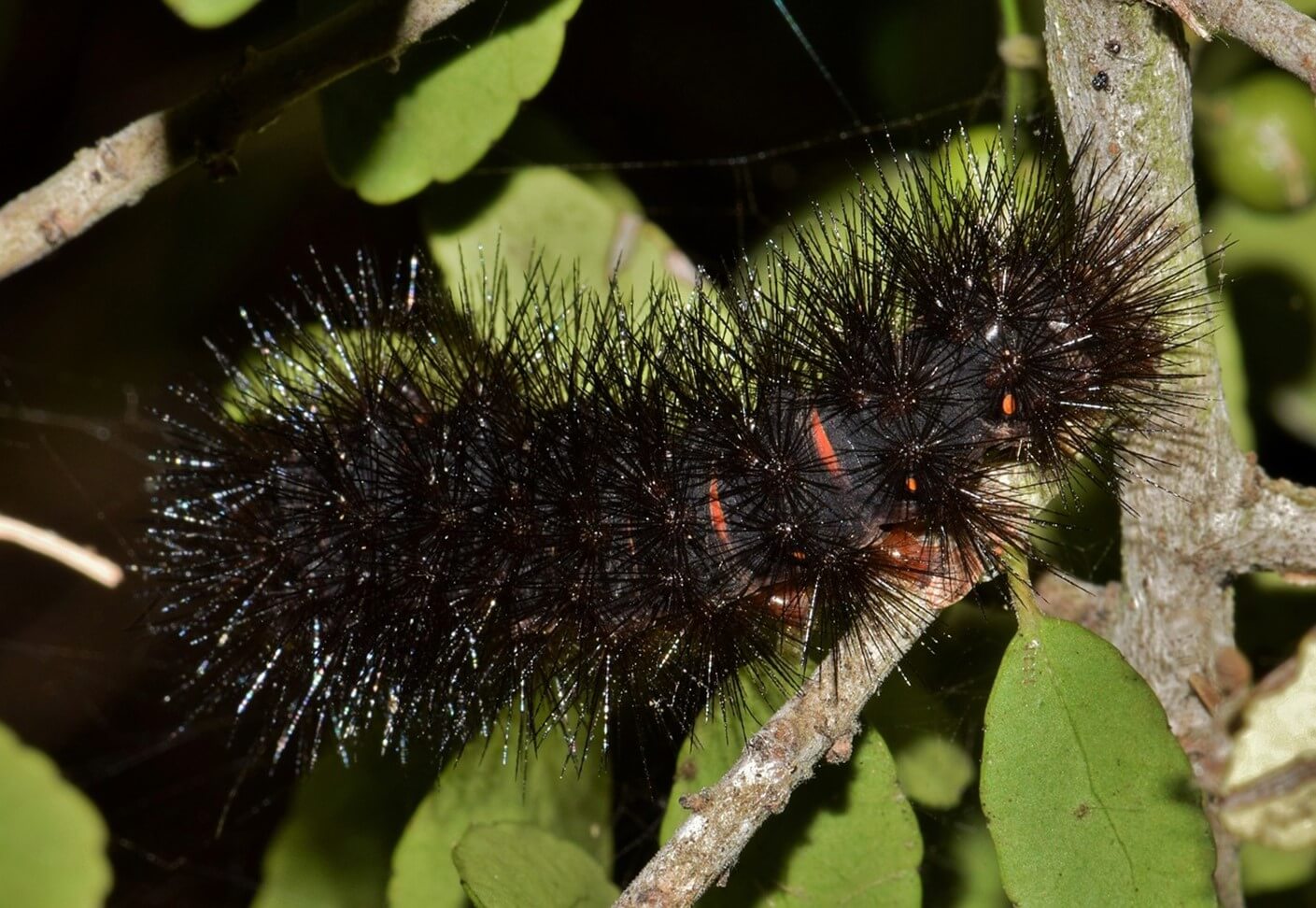
Giant Leopard Moth Caterpillars are really interesting. You can find them in gardens, where they love to eat leaves.
They look fluffy and have sharp, needle-like hairs on their back.
These hairs won’t sting you, but they can prick your skin if you touch them.
You might find these black caterpillars in many places, including Florida, Texas, Mexico, and along the East Coast of the US.”
Features to Identify Giant Leopard Caterpillars
- Color and Patterns: Look for distinctive red bands between the black spikes on their bodies.
- Body Coverage: The black spikes cover almost their entire body, making it hard to see their inner skin.
- Defense Mechanism: The spikes are not just for show; they help the caterpillar defend itself.
Garden Tiger Moth Caterpillar
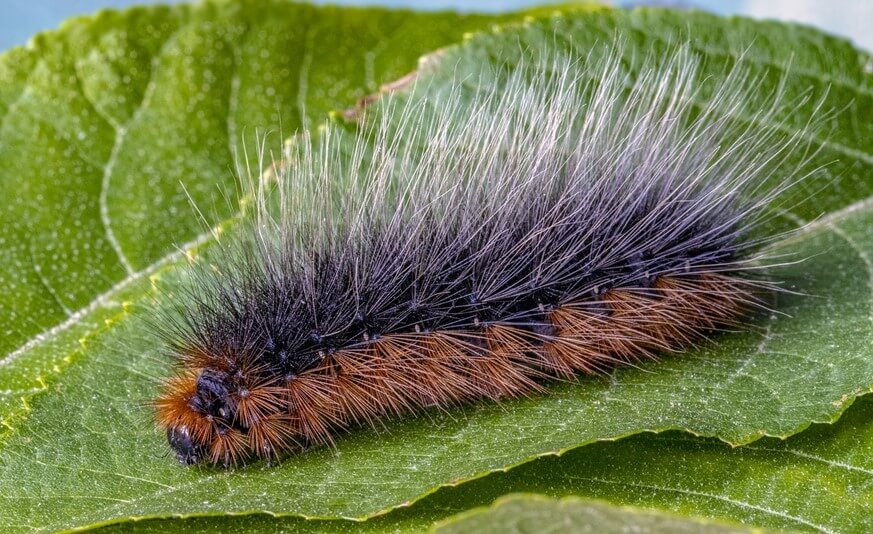
The Garden Tiger Moth Caterpillar, also called Artica Caja, is a beautiful type of black caterpillar. It stands out with its grey, white, or orange lines on its body.
While these caterpillars don’t sting, be careful because the spikes on their back can still prick and irritate your skin.
One of the most noticeable things about them is their bright orange and black colors that show up after they turn into moths.
Features to Identify Garden Tiger Moth Caterpillars
- Color: Look for their unique orange spines that stand out against their body.
- Hair Type: Noticeable long and spiky hairs are a key feature.
- Size: These caterpillars typically grow up to 6 cm in length.
Woolly Bear Caterpillar
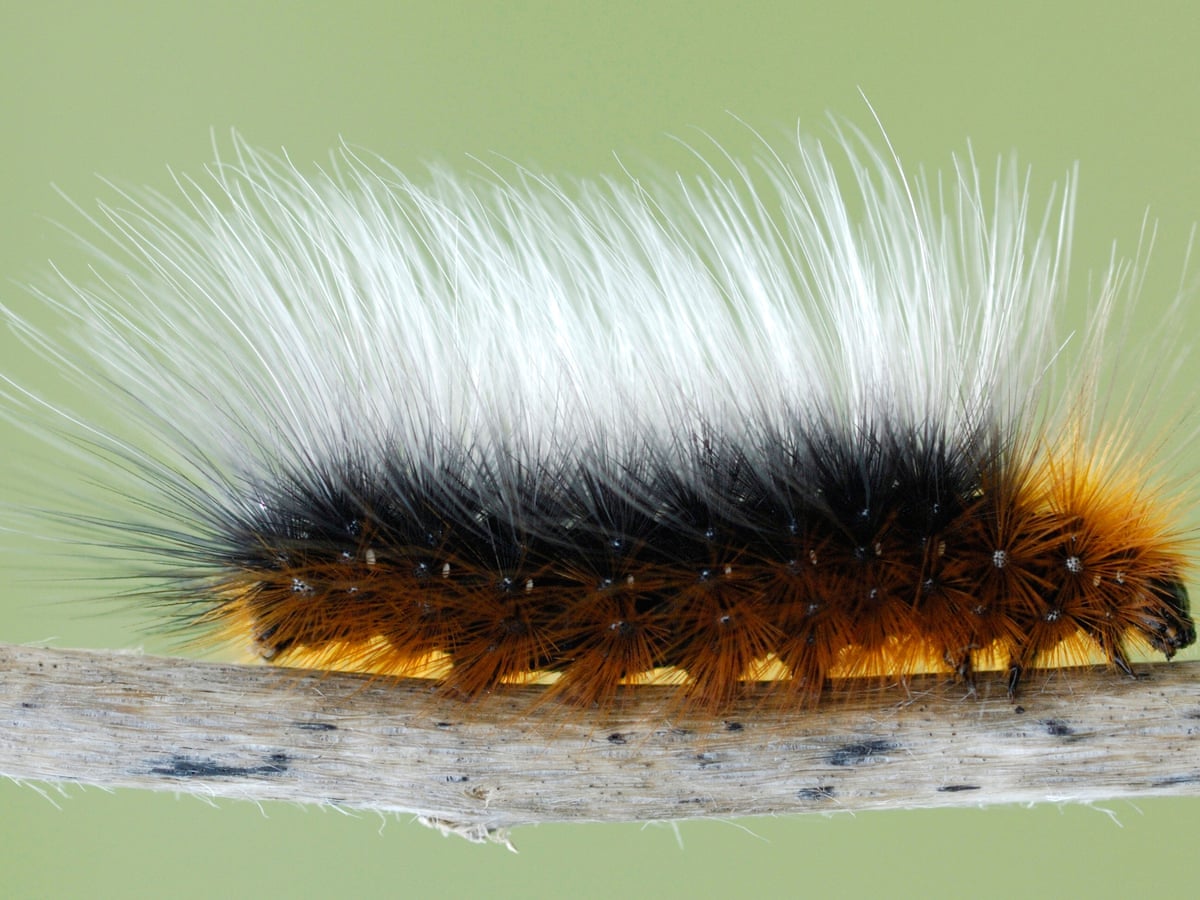
The woolly bear caterpillar, or Pyrrharctia Isabella, is a common sight in gardens.
These black caterpillars are known for their unique behavior of curling into a ball when they feel threatened.
While they are not harmful and don’t sting, touching their back can be a bit unpleasant as the spikes might prick your skin.
Features to Identify Woolly Bear Caterpillar
- Behavior: They curl into a ball in response to danger.
- Touch Sensitivity: Their spikes can irritate skin upon contact.
- Appearance: These caterpillars are covered in spiky tufts.
- Size: They grow to about 6 cm (2.3 inches) in length.
- Color: The tufts on their back are usually black or orange, contrasting with their black body.
Scarce Dagger Moth Caterpillar
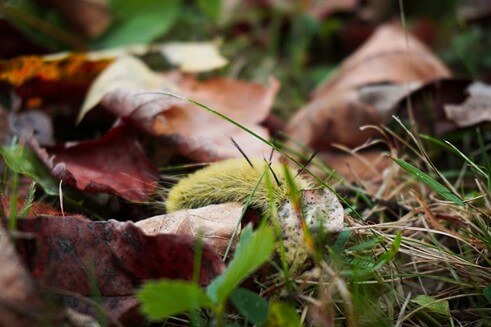
The Scarce Dagger Moth Caterpillar, scientifically named Acronicta Auricoma, is a fascinating type of black caterpillar.
Unlike the fuzzier varieties, these caterpillars have a distinct appearance with tufts in shades of orange or yellow on their backs, giving them a resemblance to wasps and other predatory insects.
Features to Identify Scarce Dagger Moth Caterpillar
- Scientific Name: Acronicta Auricoma.
- Appearance: Notable for the tufts of orange or yellow on their back.
- Texture: They have a less fuzzy texture compared to other caterpillars.
- Similarity to Predators: Their appearance is somewhat similar to wasps and predators.
Black Swallowtail Caterpillar
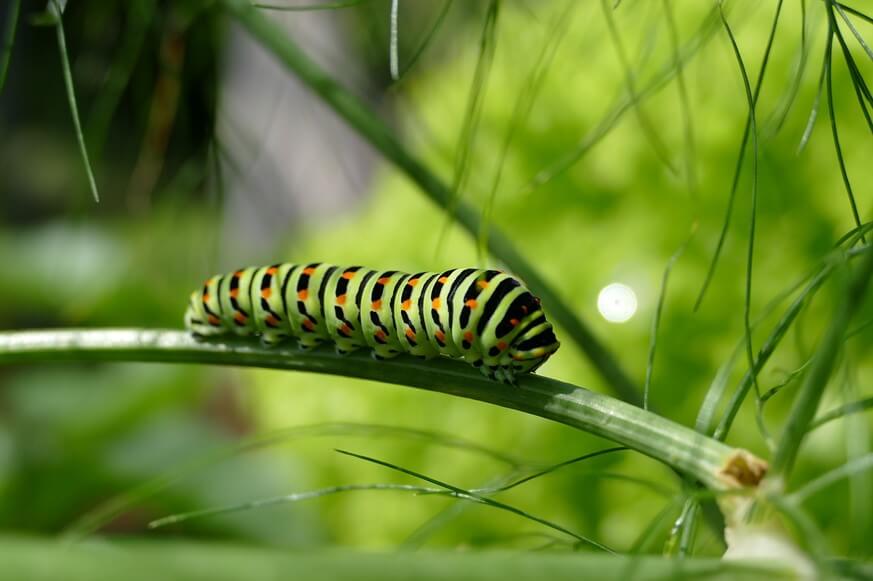
Black Swallowtail Caterpillars, known for their relatively small size, are a fascinating type of black caterpillar.
They have a unique defense mechanism where their coloration, featuring white and yellow markings, mimics bird droppings, helping them avoid predators.
These caterpillars are commonly found feeding on carrot leaves and parsley, which has led to them being nicknamed ‘parsley worms.’
Features to Identify Black Swallowtail Caterpillar
- Size: They are smaller compared to other caterpillar species.
- Markings: Distinct white and yellow markings on their body.
- Defense Mechanism: Their coloration resembles bird droppings for protection.
- Diet: Known for feeding on carrot leaves and parsley.
- Nickname: Often called ‘parsley worms’ due to their dietary preferences.
Walnut Caterpillar
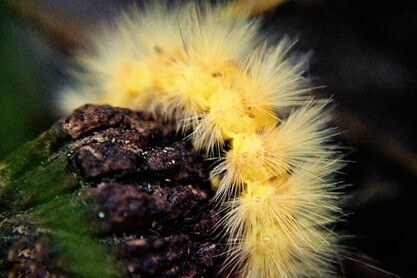
The Walnut Caterpillar is another intriguing black caterpillar, part of the Notodontidae family.
These caterpillars are known for their processionary movement and striking white, spindle-like spines covering their bodies.
Interestingly, despite their hairy appearance, they don’t typically cause skin irritation, making them safer to handle than some other caterpillar varieties.
Features to Identify Walnut Caterpillars
- Family: Belongs to the Notodontidae family.
- Appearance: Distinguished by white, spine-like spindles covering their body.
- Movement: Known for their processionary movement.
- Skin Irritation: Unlike many hairy caterpillars, they usually don’t cause skin irritation.
Peacock Butterfly Caterpillar
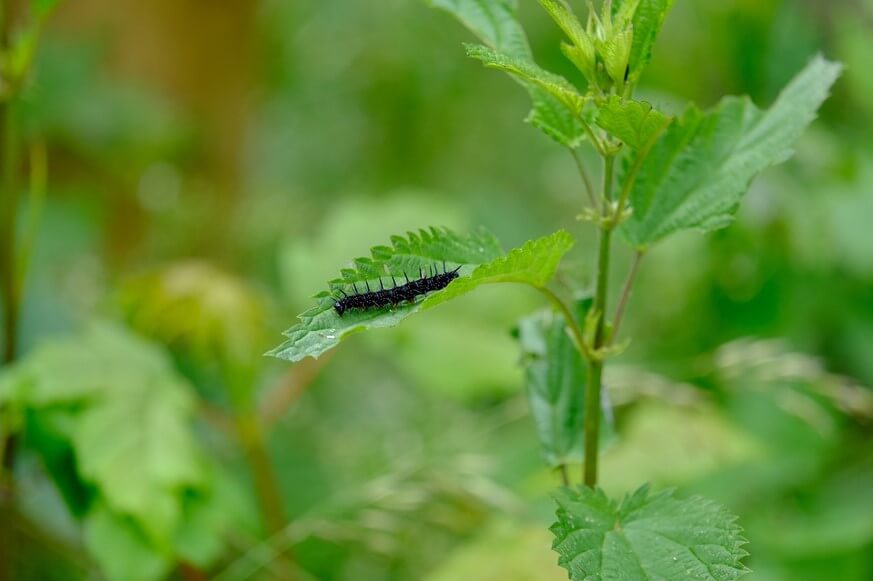
The Peacock Butterfly Caterpillar, scientifically named Aglais io, is a rare and visually striking black caterpillar.
Notable for its glossy black body adorned with white dots, it presents a stunning appearance, especially in sunlight.
Commonly found in parts of Asia and Europe, these caterpillars are known for being harmless as they don’t sting.
Features to Identify the Peacock Butterfly Caterpillars
- Scientific Name: Aglais io.
- Appearance: Shiny black body with distinct white dots.
- Rarity: Considered rare and unusual.
- Habitat: Found in specific regions of Asia and Europe.
- Harmlessness: Belongs to the non-stinging category of caterpillars.
Pipevine Swallowtail Caterpillar
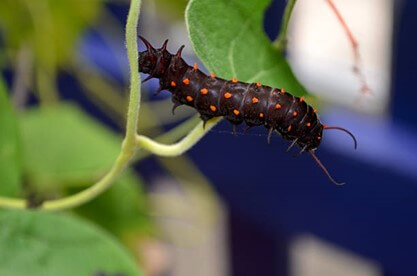
The Pipevine Swallowtail Caterpillar, scientifically called Battus philenor, is a member of the Papilionidae family.
These black caterpillars are distinguished by their orange and red spines.
An interesting feature of these caterpillars is their ability to cling to objects with a tongue-like organ located behind their head, which also serves as a defense mechanism.
They typically feed on Pipevine plants and are recognized by their notably thicker tails.
Features to Identify the Pipevine Swallowtail Caterpillar
- Scientific Name: Battus philenor.
- Family: Part of the Papilionidae family.
- Appearance: Marked by orange and red spines on their body.
- Unique Feature: Ability to cling to objects with a tongue-like organ for defense.
- Diet: Primarily feed on Pipevine plants.
- Tail Characteristic: Their tail is thicker than the rest of the body.
Azalea Caterpillars
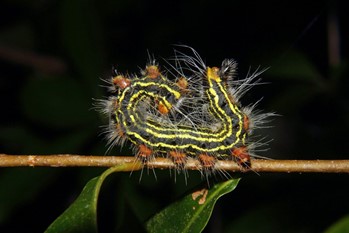
Azalea Caterpillars, recognized for their long bodies and distinctive coloring, are often spotted in Kansas and along the East Coast of the United States.
They have a unique appearance with reddish-brown prolegs and a round, orange-colored head.
These caterpillars are particularly noted for their tendency to damage crops and plants.
Features to Identify the Azalea Caterpillars
- Appearance: Long body with reddish-brown prolegs and a round, orange head.
- Region: Commonly found in Kansas and the East Coast region of the US.
- Impact on Plants: Known for causing damage to crops and various plants.
Conclusion
Overall, the world of black caterpillars is a diverse and fascinating one, filled with unique and varied species.
From the common Woolly Bear to the rare Peacock Butterfly Caterpillar, each type has its own distinct characteristics and behaviors.
While some, like the Walnut and Pipevine Swallowtail caterpillars, are known for their striking appearances, others like the Azalea Caterpillar are recognized for their impact on plants.
These caterpillars not only play a vital role in our gardens and ecosystems but also captivate us with their transformation into beautiful moths and butterflies.
Understanding these caterpillars better can help us appreciate the biodiversity in our surroundings and encourage us to protect their natural habitats. As
we’ve seen, even the small and often overlooked black caterpillar has a story to tell and a beauty to unveil in the grand tapestry of nature.

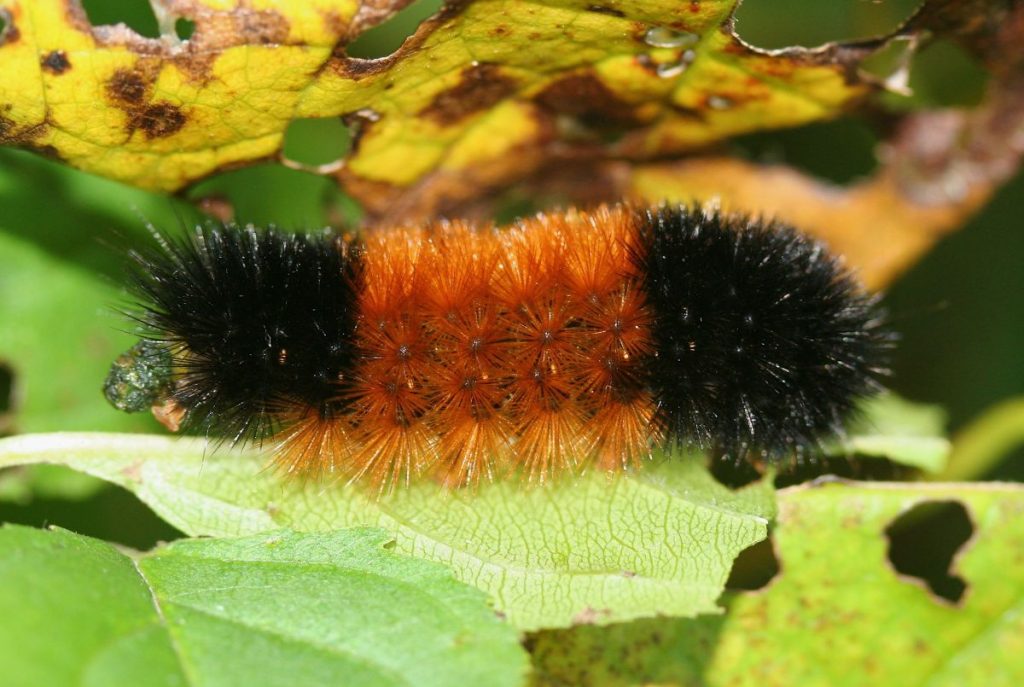
I have a caterpillar on my Mountain Ash . It has stripes going down it’s back of yellow, black and white. On the black stripe there are red dashes it has a tuft at one end and a b,lack horn at the other end. The yellow stripe is on top.
. Could you please assist in naming this for me.
killenspepper@gmail.com. Thank you.